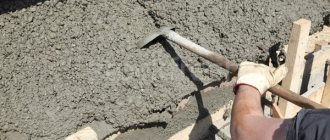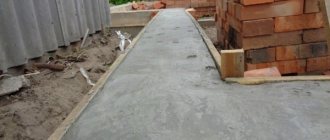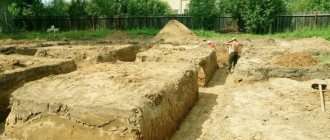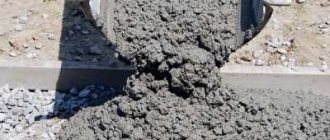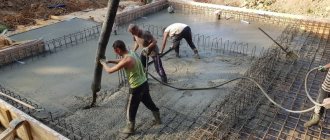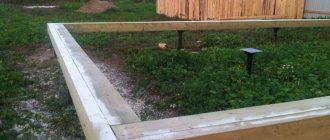Pouring the foundation is the initial stage of building a house. The word “foundation” has now acquired a broader meaning, thanks to the enormous importance of the foundation in the fate of the house. No matter how strong the walls are, no matter how advanced the construction technology, a poor-quality foundation can suddenly turn the housing stock into non-residential. As a result of soil movements and frost heaving, a change in the geometry of the foundation occurs, and as a result, cracking of the walls. It is not in the best interests of the homeowner to allow this scenario to happen. This means that the construction of the foundation should be considered as a key stage in the construction of a house.
Making concrete at the pouring site yourself
Let's first consider the option when concrete for the foundation is made on site by mixing cement, crushed stone and sand in a concrete mixer. The volume of such a concrete mixer ranges from 50 to 170 liters on average. To pour one cubic meter of concrete into the foundation, you will need to mix the concrete about 10 times. The concrete mixer is loaded manually, which means hundreds of kilograms. The question of the quality of the resulting concrete also remains open. It takes an average of 4-6 hours to produce a cubic meter. At the same time, it is almost impossible to work alone, because... it is necessary to compact the poured concrete. A lot of time is spent cleaning containers, shovels and tools. During more or less serious construction, concrete is not made in small portions on site using a mini-concrete mixer, but delivery is ordered by concrete mixer trucks. Check with local contractors to find out which manufacturer has good quality concrete.
How concrete matures
There are heated debates on construction forums regarding the partial pouring of the foundation. Some users argue that this will dramatically negatively affect the strength of the foundation of the house and will eventually lead to its destruction. Others counter that such a foundation will be no less strong than one made of concrete blocks.
Both sides provide many other arguments in favor of their point of view. But if you want to understand for yourself whether it is possible to fill the foundation in parts, you need to understand what processes occur in the concrete from the moment it is prepared and what will happen if you interfere with them.
Concrete is sand and crushed stone, the particles of which are bonded to each other with cement glue. The process of forming bonds within the material begins when dry ingredients are mixed with water, triggering chemical reactions.
Scheme of structural transformations in concrete Source profipol.dp.ua
At the first stage, there is an active reaction between water and cement with the formation of crystals. It lasts several hours, during which the water molecules gradually bind and the solution loses its mobility. The reaction rate depends on external environmental conditions, and primarily on air temperature, as well as humidity, precipitation, and wind. In dry and hot weather, it can end in 2-3 hours, and in low temperatures and high humidity levels only after 8-10 hours.
During this period, the solution should not be stirred, poured with water, or generally interfere with the process in any way, so as not to disrupt the bonds formed.
The next stage is characterized by the growth of crystalline bonds into each other. It goes slowly, but for a long time. Concrete reaches its design hardness and strength only after a month; it is recommended to maintain this period of time before starting to load the foundation by erecting the walls of a house on it.
If concrete is not pressed under the weight of a person, this does not mean that it has finally matured Source pol-exp.com
But we are interested in another question - is it possible to fill the strip foundation in parts, how the bottom layer will behave when pouring fresh mortar, how good is the adhesion of the layers.
See also: Catalog of companies that specialize in calculation, installation and repair of foundations
Cold seam
If the time interval between pours exceeds a day, another technology for connecting layers of concrete is used, called a cold seam. In this case, pouring can be continued only after the first layer of concrete has hardened. This method is less preferable because the layered structure is heterogeneous. In addition, there are a number of requirements for such layered foundations:
- The reinforcement should not pass along the joint of the seams. Those. horizontal rods should be located entirely in their own layer of concrete, but not between layers. The same goes for vertical reinforcement bars.
- If layers are poured horizontally, then the number of layers should not exceed two.
- A multi-layer foundation structure does not work as well as a single-layer one, or in extreme cases, a two-layer one.
- Thin horizontal layers are not acceptable. If, for objective reasons, the foundation is poured in several stages, the joints must be vertical. For this purpose, temporary partitions are used when pouring.
What happens to concrete when pouring layer by layer
In the first hours after pouring, while the so-called “liquid” setting phase continues, a fresh portion of the solution can be laid on the yet unbound moving concrete. Particles in the lower layers elastically perceive the load; they are easily redistributed under the weight of the upper layer, since they are not yet connected to each other. And the fresh solution will easily “grow” into the already laid mass.
But from the moment when the crystals begin to grow together and until these bonds are significantly strengthened, concrete cannot be loaded. This will cause deformations in the thickness of the still weak concrete and the appearance of cracks that interrupt the bonds. Such a foundation will not be strong and will not be able to support the weight of the building - it will gradually collapse.
Cracks under the influence of groundwater and precipitation will increase Source wallbox.ru
Therefore, experts give a positive answer to the question whether it is possible to fill the foundation in parts over several days only if the next layer is laid no earlier than three days after the previous one. This is the minimum period required for concrete to harden and acquire resistance to loads in the lower layers.
But in this case, you will have to solve the problem of a “cold joint”, as the joint between layers of concrete of different degrees of maturation is called. The fresh solution will harden on its own without forming bonds with the already set concrete. In fact, such a foundation cannot be called monolithic, since each of its layers is a separate load-bearing element of the structure. And these unrelated elements can move relative to each other.
Horizontal cold weld Source penetron-simf.ru
But there are ways by which you can achieve the integrity of a concrete strip or slab and give it the properties of a monolith.
Requirements for concrete compaction
There is a mandatory requirement to compact concrete when pouring. If compaction is not carried out, numerous air bubbles remain in the concrete. After hardening, these bubbles disrupt the integrity of the concrete mixture, causing premature destruction and a decrease in the strength of the product. Compaction can be done in two ways. The first, most correct way is using a deep vibrator. If you fill it yourself, this useful device can be rented daily. The vibrator is immersed in the poured mixture, turned on, and air bubbles in the vibrating concrete can already escape to freedom. When working, it is important not to touch the reinforcement elements of the foundation. The second method for “homemade filling” is bayoneting. After pouring, the reinforcement is immersed in the concrete mixture, as if pierced through the foundation, and so many times in all parts of the poured concrete. Since the movement is similar to stabbing an enemy with a bayonet, this process is called bayoneting. In this case, it will also be useful to tap the formwork properly so that air bubbles from the walls of the future foundation are released.
Preparatory work before pouring with a mixer
When performing foundation work, there are 2 options for preparing a concrete mixture:
- Preparation of the mixture directly on the construction site using special equipment.
- Preparing concrete for pouring using a mixer.
Each method has its own characteristics, but using a mixer seems more practical in terms of efficiency.
Preparing the area for the mixer entrance
Using a mixer can significantly speed up the process of pouring the base. Special equipment shows excellent results on various objects. The mixer supplies the work site with a ready-made mixture with the specified consistency parameters, which significantly speeds up the process of pouring the foundation. Preparing concrete in a factory results in obtaining strictly established characteristics, which means it makes the work more profitable and efficient.
Direct filling is carried out during the day. The resulting monolithic foundation has sufficient strength and evenly distributed reliability.
To increase work efficiency, you must strictly follow the work technology. It is important to carry out the preparatory work accurately so that the strength of the structure is sufficient.
To begin with, it is necessary to properly organize the entry of the mixer into the site and accessibility to all parts of the base. For this purpose, a route of movement around the site is planned. Without this stage and preparation, difficulties will arise during the work process that reduce the speed of work and worsen the result.
Before pouring, formwork must be installed around the perimeter of the foundation. It serves as a form for the subsequent formation of the base. Depending on the thickness of the foundation being created, the strength of the installed supports that secure the formwork is determined. A reinforcing frame is installed from selected rods.
Immediately before starting pouring, it is important to inspect the concrete mixture for consistency and the presence of clots. After inspection, you can begin to create the foundation.
Advantages of concrete delivered by mixer
Automated concrete mixers or mixers are designed for more than just transporting concrete. They mix the components to the desired consistency and deliver the solution directly to the pouring site. Pouring ready-mixed concrete with a mixer has a lot of advantages, compared to which the price issue loses its significance.
For example:
- The mixer is capable of simultaneously delivering up to 8-10 cubic meters of the finished mixture;
- Significant time savings and reduction in installation time. The ordered concrete is mixed at the factory and immediately loaded without waiting for it to be ready. While the mixer is traveling to the place, the mixture acquires all the necessary properties.
- The finished solution in a mixer is an order of magnitude better quality than that made by hand. This is a homogeneous mixture of a given consistency, which greatly simplifies its leveling on the surface.
- Pouring the foundation for a country house or a multi-storey complex with concrete from a mixer can proceed continuously. This guarantees high density and solidity of the finished substance. What would take a week to do by hand can be done in one day using a mixer.
- At the request of the customer, plasticizers and modifiers are added to the main ingredients of concrete at the plant, which gives the building mass high waterproofing properties.
Key rules for receiving concrete
When concluding a contract for the supply of concrete mortar, the customer and supplier must provide for all risks and nuances. Thus, the likelihood of penalties and various costs is minimized. The client must provide free access to the construction site to simplify the process of unloading products. The consumer has every right to control whether the mixture meets the stated technical characteristics. The sample is taken in the presence of the driver, after which it is necessary to draw up a report in two copies. The performance properties of concrete are studied for no more than 20 minutes. If a shortage is detected, the seller must compensate the difference within 30 days. If quality standards are not met, the mixture must be disposed of in accordance with generally accepted regulations.

